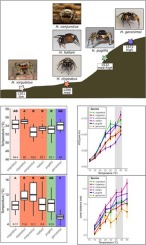当前位置:
X-MOL 学术
›
J. Insect Physiol.
›
论文详情
Our official English website, www.x-mol.net, welcomes your
feedback! (Note: you will need to create a separate account there.)
Low temperatures impact species distributions of jumping spiders across a desert elevational cline.
Journal of Insect Physiology ( IF 2.3 ) Pub Date : 2020-02-19 , DOI: 10.1016/j.jinsphys.2020.104037 Erin E Brandt 1 , Kevin T Roberts 2 , Caroline M Williams 2 , Damian O Elias 1
Journal of Insect Physiology ( IF 2.3 ) Pub Date : 2020-02-19 , DOI: 10.1016/j.jinsphys.2020.104037 Erin E Brandt 1 , Kevin T Roberts 2 , Caroline M Williams 2 , Damian O Elias 1
Affiliation

|
Temperature is known to influence many aspects of organisms and is frequently linked to geographical species distributions. Despite the importance of a broad understanding of an animal's thermal biology, few studies incorporate more than one metric of thermal biology. Here we examined an elevational assemblage of Habronattus jumping spiders to measure different aspects of their thermal biology including thermal limits (CTmin, CTmax), thermal preference, V̇CO2 as proxy for metabolic rate, locomotor behavior and warming tolerance. We used these data to test whether thermal biology helped explain how species were distributed across elevation. Habronattus had high CTmax values, which did not differ among species across the elevational gradient. The highest-elevation species had a lower CTmin than any other species. All species had a strong thermal preference around 37 °C. With respect to performance, one of the middle elevation species was significantly less temperature-sensitive in metabolic rate. Differences between species with respect to locomotion (jump distance) were likely driven by differences in mass, with no differences in thermal performance across elevation. We suggest that Habronattus distributions follow Brett's rule, a rule that predicts more geographical variation in cold tolerance than heat. Additionally, we suggest that physiological tolerances interact with biotic factors, particularly those related to courtship and mate choice to influence species distributions. Habronattus also had very high warming tolerance values (> 20 °C, on average). Taken together, these data suggest that Habronattus are resilient in the face of climate-change related shifts in temperature.
中文翻译:

低温会影响穿越沙漠海拔线的跳跃蜘蛛的物种分布。
已知温度会影响生物的许多方面,并且通常与地理物种分布有关。尽管对动物的热生物学有广泛了解的重要性,但很少有研究包含不止一种度量热生物学。在这里,我们检查了Habronattus跳跃蜘蛛的高程组合,以测量其热生物学的不同方面,包括热极限(CTmin,CTmax),热偏好,V̇CO2作为代谢率,运动行为和温暖耐受性的代表。我们使用这些数据来测试热生物学是否有助于解释物种如何在海拔高度分布。Habronattus具有较高的CTmax值,跨海拔梯度的物种间没有差异。海拔最高的物种的CTmin低于其他任何物种。所有物种在37°C左右都有强烈的热偏好。在性能方面,中海拔物种之一对代谢率的温度敏感性明显较低。物种之间的运动(跳跃距离)差异可能是由质量差异驱动的,而整个海拔的热力性能没有差异。我们建议Habronattus分布遵循布雷特法则,该法则预测耐寒性比热量更多的地理差异。此外,我们建议生理耐受性与生物因素相互作用,特别是与求爱和择偶有关的因素,以影响物种分布。Habronattus还具有很高的升温耐受性值(平均> 20°C)。在一起
更新日期:2020-03-20
中文翻译:

低温会影响穿越沙漠海拔线的跳跃蜘蛛的物种分布。
已知温度会影响生物的许多方面,并且通常与地理物种分布有关。尽管对动物的热生物学有广泛了解的重要性,但很少有研究包含不止一种度量热生物学。在这里,我们检查了Habronattus跳跃蜘蛛的高程组合,以测量其热生物学的不同方面,包括热极限(CTmin,CTmax),热偏好,V̇CO2作为代谢率,运动行为和温暖耐受性的代表。我们使用这些数据来测试热生物学是否有助于解释物种如何在海拔高度分布。Habronattus具有较高的CTmax值,跨海拔梯度的物种间没有差异。海拔最高的物种的CTmin低于其他任何物种。所有物种在37°C左右都有强烈的热偏好。在性能方面,中海拔物种之一对代谢率的温度敏感性明显较低。物种之间的运动(跳跃距离)差异可能是由质量差异驱动的,而整个海拔的热力性能没有差异。我们建议Habronattus分布遵循布雷特法则,该法则预测耐寒性比热量更多的地理差异。此外,我们建议生理耐受性与生物因素相互作用,特别是与求爱和择偶有关的因素,以影响物种分布。Habronattus还具有很高的升温耐受性值(平均> 20°C)。在一起









































 京公网安备 11010802027423号
京公网安备 11010802027423号